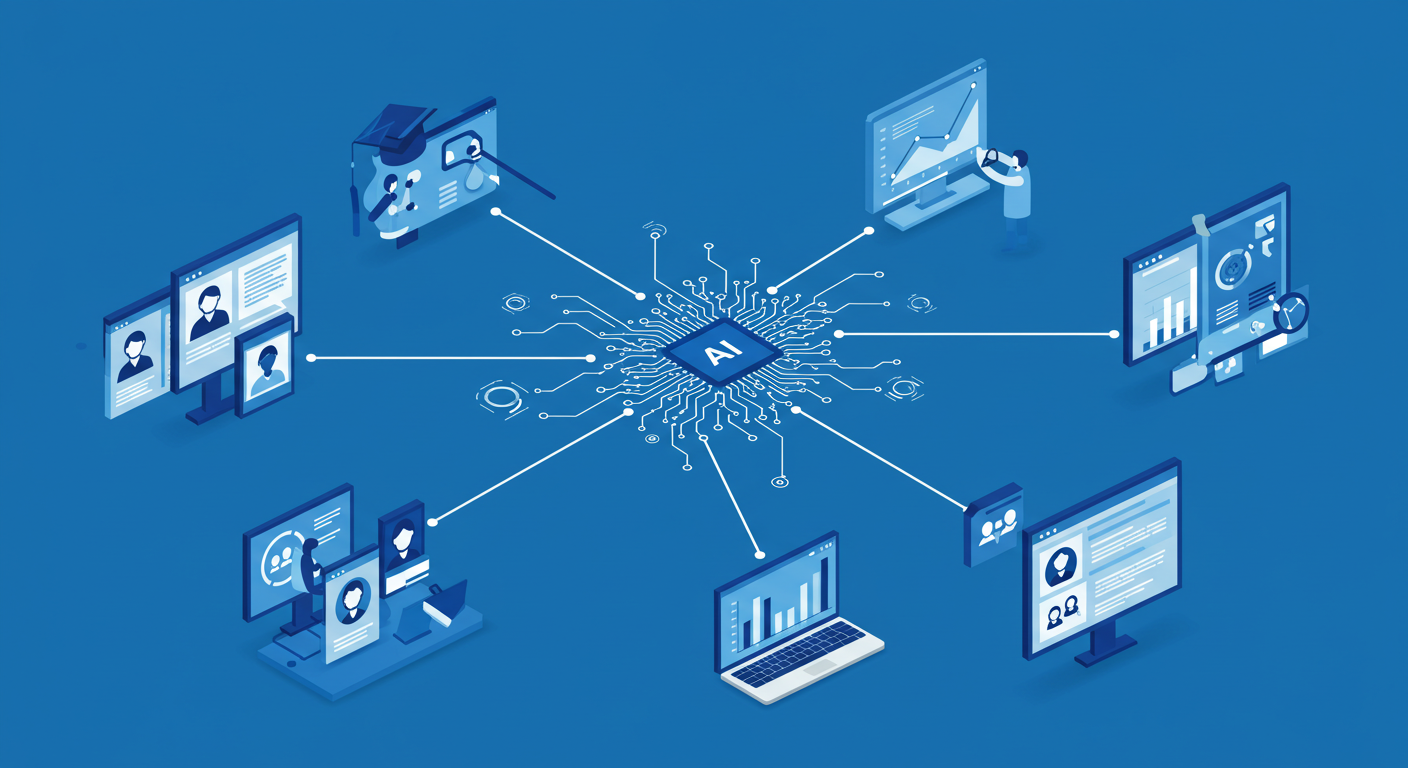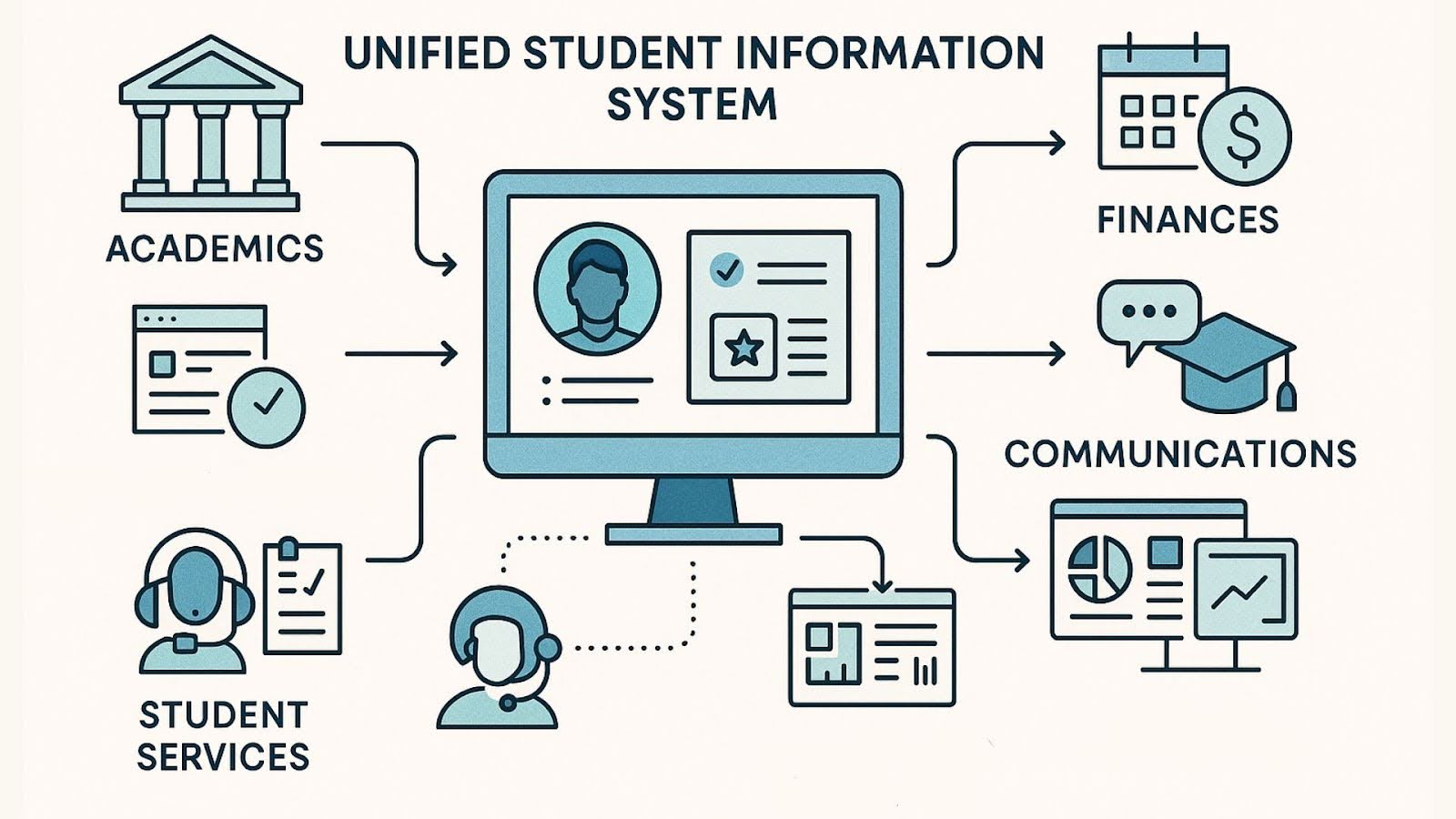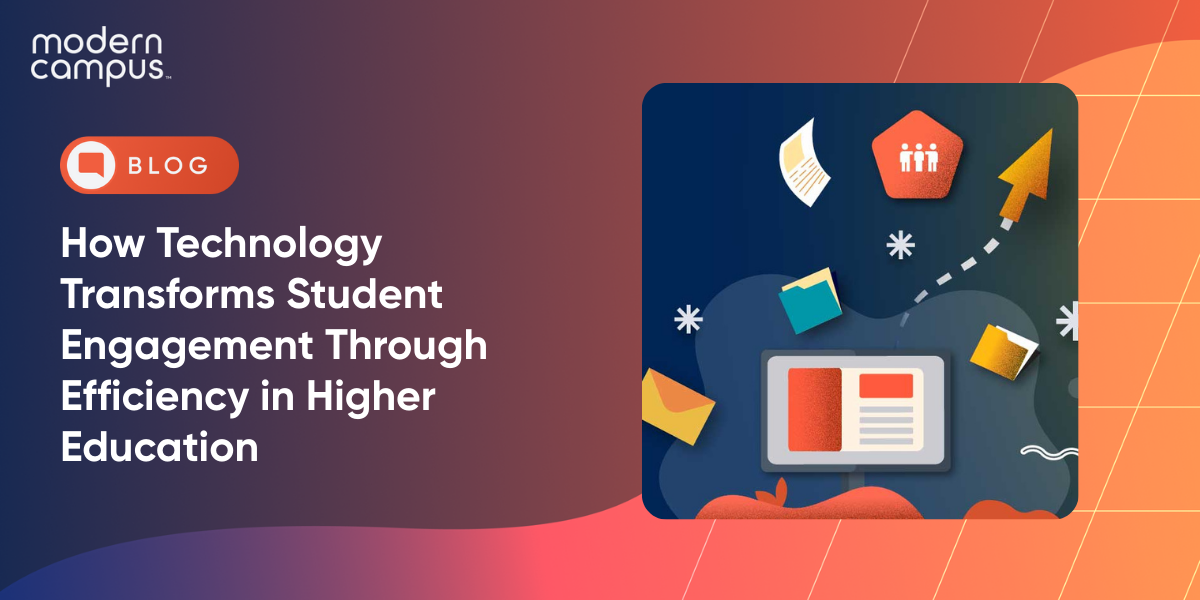How Technology Transforms Student Engagement Through Efficiency in Higher Education
Modern technology creates a powerful cycle where operational efficiency directly drives student engagement in higher education.
- Automated systems free staff to focus on meaningful student interactions, improving relationship quality
- Real-time data analytics enable personalized interventions that boost engagement and retention rates
- Integrated platforms streamline the student experience, meeting digital-native expectations for seamless interactions
- Smart institutions investing in efficiency-focused technology see measurable improvements in both operational metrics and student satisfaction
When your campus operations run smoothly behind the scenes, students feel the difference in every interaction.
Remember the frustration of waiting in endless lines for course registration? Or the confusion of navigating multiple disconnected systems just to check your financial aid status? Those days are becoming history at forward-thinking institutions that understand a fundamental truth: operational efficiency in education creates the kind of seamless, responsive environment where student engagement naturally thrives.
Today's students arrive on campus as digital natives who expect the same level of technological sophistication they experience with their favorite apps and online services. According to Pew Research data, nearly half of teens report being online "almost constantly," and they bring these digital expectations directly into their educational experience. When you support them through efficient, technology-enabled operations, student engagement follows naturally.
The connection between efficiency and engagement isn't coincidental. Streamlined administrative processes and integrated data systems create a campus ecosystem that can respond quickly and thoughtfully to individual student needs.
What's the Real Connection Between Operational Efficiency and Student Engagement?
The relationship between efficiency in education and student engagement runs deeper than most administrators realize. It's not just about faster registration or shorter wait times, though those certainly matter. The real magic happens when streamlined operations create space for the human connections that drive authentic engagement.
When your admissions team spends hours manually transferring data between systems, they have less time to personally guide prospective students through their decision-making process. When advisors struggle with outdated scheduling systems, they can't focus on developing meaningful mentoring relationships. When students encounter friction at every digital touchpoint, their initial enthusiasm for your institution begins to erode before they even attend their first class.
EDUCAUSE's 2024 Higher Education Trend Watch identifies institutional resilience as a top priority, emphasizing how technology infrastructure directly impacts an institution's ability to support student success. This resilience creates sustainable systems that consistently deliver positive student experiences.
Students judge institutions by their worst interaction, not their best. A single frustrating encounter with a clunky system or an unresponsive process can overshadow months of excellent teaching and programming. Conversely, when every touchpoint feels intuitive and responsive, students develop a sense of trust and confidence that enhances their overall engagement.
The efficiency-engagement connection also extends to how institutions use their human resources. When technology automatically handles routine tasks, staff members can dedicate their expertise to activities that directly impact student success: proactive outreach to struggling students, personalized career guidance, innovative programming that builds community and relationship-building that transforms a transaction-based education into a transformational experience.
How Does AI Automation Revolutionize Student Engagement?
Artificial intelligence is reshaping how institutions approach both efficiency in education and student engagement. Today's AI systems are sophisticated enough to understand context, predict needs and personalize interactions at scale.

Predictive Analytics for Proactive Support
Modern AI systems analyze patterns in student behavior to identify engagement risks before they become retention problems. These systems can detect when a student's LMS activity drops, when their grades begin trending downward or when their campus involvement decreases. Instead of waiting for students to seek help, institutions can proactively reach out with targeted support.
For example, an AI system might notice that a student who typically submits assignments early suddenly starts missing deadlines. It can automatically alert advisors, suggest relevant tutoring resources or trigger personalized messages with specific study strategies. This level of personalized attention was impossible to scale manually, but AI makes it routine.
Automated Administrative Excellence
Higher education involves thousands of repetitive tasks that, while necessary, don't directly contribute to student engagement. AI handles routine processes with remarkable efficiency while enabling staff to concentrate on strategic guidance and relationship-building.
Consider the enrollment process: AI can automatically verify transcripts, calculate transfer credits, check prerequisite requirements and suggest optimal course sequences based on a student's goals and schedule preferences. What once required multiple staff touchpoints and weeks of processing can now happen in minutes, giving students immediate feedback and allowing enrollment counselors to spend their time on guidance rather than data entry.
Personalization at Scale
AI enables true personalization without requiring proportional increases in staffing. The technology can customize communications based on a student's interests, academic progress, involvement preferences and communication style. A first-generation college student might receive different resources and messaging than a transfer student or an international learner.
AI-powered platforms can adapt course content, suggest study materials and modify assignment sequences based on individual learning patterns. When students feel that their education is tailored to their specific needs and goals, engagement increases dramatically.
What Role Do Modern Student Information Systems Play in Engagement?
Student Information Systems have evolved from simple data repositories into sophisticated engagement platforms that change how institutions interact with their students. Today's SIS platforms serve as the central nervous system of student engagement, connecting every aspect of the educational experience into a cohesive, responsive ecosystem.

Breaking Down Data Silos
Traditional approaches to student data management created frustrating silos where different departments maintained separate systems with overlapping but inconsistent information. Students would provide the same basic information multiple times, and staff couldn't access comprehensive views of student needs and progress.
Modern SIS platforms eliminate these silos by creating unified student profiles that update in real time across all institutional touchpoints. When a student updates their contact information in one system, it automatically propagates everywhere. When they register for courses, their financial aid automatically adjusts, their academic planning tool updates degree progress and relevant campus services receive notifications to proactively reach out with resources.
Real-Time Engagement Tracking
Contemporary SIS platforms actively track engagement indicators and provide actionable insights. These systems can monitor everything from LMS logins and assignment submissions to campus event attendance and career services interactions. The result is a comprehensive picture of each student's engagement level that enables targeted interventions.
For instance, if the system detects that a typically engaged student hasn't accessed course materials for several days, it can automatically trigger check-ins from advisors or classmates. If a student's engagement metrics suggest they're thriving, the system might recommend leadership opportunities or advanced coursework that matches their interests.
Integrated Communication and Engagement Tools
The most effective SIS platforms integrate smoothly with communication and engagement tools, creating seamless workflows that enhance natural interactions. Student engagement software works best when it connects automatically with the SIS to access up-to-date student information and trigger appropriate responses.
This integration enables automated milestone celebrations, timely deadline reminders and personalized resource recommendations. Students receive relevant information precisely when they need it, delivered through their preferred communication channels.
How Do Communication Technologies Amplify Student Engagement?
Communication technology has become the bridge between efficiency in education and meaningful student engagement. When implemented thoughtfully, communication tools create opportunities for more frequent, personalized and impactful interactions between students and their institutions.

Multi-Channel Engagement Strategies
Today's students text, email, use apps, engage on social media and participate in video calls depending on the context and urgency of the situation. Effective communication meets students where they are, using the right channel for the right message at the right time.
Text messaging has proven particularly powerful for time-sensitive communications like registration deadlines, course changes and emergency notifications. However, it's equally valuable for building ongoing engagement through regular check-ins, milestone celebrations and personalized encouragement. When students receive a text congratulating them on their academic progress or reminding them about relevant campus events, they feel noticed and valued.
AI-Enhanced Personal Communication
Modern communication platforms use artificial intelligence to personalize interactions without losing authenticity. These systems can analyze response patterns, communication preferences and engagement history to tailor both the content and timing of messages. A student who typically responds to emails in the evening might receive their course recommendations at 7 PM, while an early riser might get the same information at 8 AM.
The technology can also adapt messaging tone and content based on what resonates with individual students. Some students respond well to achievement-focused language, while others prefer community-oriented messaging. AI enables institutions to automatically adjust their communication approach for maximum impact.
24/7 Support Through Intelligent Automation
One of the most significant advantages of modern communication technology is its ability to provide immediate responses to student questions and concerns. Intelligent chatbots and virtual assistants can instantly handle routine inquiries while seamlessly escalating complex issues to human staff members.
This immediate responsiveness meets student expectations for instant access to information while creating more time for staff to handle complex student support needs that require human insight and empathy. When students can get quick answers to simple questions, they're more likely to engage with the institution for more substantial needs.
5 Cutting-Edge Technologies Revolutionizing Student Engagement
Emerging technologies are shaping the future of student engagement. These innovations are improving existing processes and creating entirely new possibilities for how students connect with their education and their institutions.
1. Virtual and Augmented Reality Learning Environments
VR and AR technologies are transforming abstract concepts into immersive experiences that dramatically increase engagement. Students can walk through ancient Rome, manipulate molecular structures in three-dimensional space or practice complex procedures in risk-free virtual environments. These technologies are particularly powerful for visual and kinesthetic learners who struggle with traditional lecture-based instruction.
2. Blockchain for Credential Management and Academic Verification
Blockchain technology is creating new possibilities for secure, instant verification of academic credentials while enabling innovative micro-credentialing programs. Students can earn and display verified digital badges for specific skills and achievements, creating more nuanced pictures of their capabilities than traditional transcripts allow.
3. Internet of Things (IoT) and Smart Campus Technologies
IoT sensors and connected devices are creating responsive campus environments that adapt to student needs in real time. Smart systems can automatically adjust lighting and temperature based on occupancy, help students find available study spaces and track foot traffic patterns to optimize campus layouts for maximum student interaction.
4. Machine Learning for Adaptive Content Recommendation
Advanced machine learning algorithms analyze learning patterns, interests and goals to recommend personalized content, courses and experiences. These systems help students discover opportunities they might never have found otherwise, increasing engagement with both curricular and co-curricular programs.
5. Voice-Based Assessment and Interaction Technologies
Voice recognition and natural language processing are enabling new forms of assessment and interaction that feel more conversational and less intimidating than traditional testing methods. Students can demonstrate knowledge through spoken responses, receive verbal feedback and interact with educational content using natural speech patterns.
What Metrics Actually Matter for Measuring Engagement Success?
Effectively measuring student engagement requires looking beyond traditional metrics like graduation rates and GPA. While these outcomes remain important, they're lagging indicators that don't provide actionable insights for improvement. The most successful institutions focus on leading indicators that predict engagement trends and enable proactive interventions.
Real-Time Engagement Indicators
Modern analytics platforms track dozens of engagement signals: LMS activity patterns, campus facility usage, event attendance, peer interaction frequency and digital resource utilization. The key is identifying which combinations of metrics provide early warnings about engagement drops.
Institutions are discovering that engagement patterns can provide early warnings about academic struggles. By tracking these patterns, institutions can intervene before problems become crises.
Holistic Success Measurements
The most meaningful engagement metrics consider the whole student experience, not just academic performance. Engaged students report higher levels of belonging, clearer career direction and stronger connections to institutional values.
Effective measurement systems track both quantitative metrics (participation rates, completion rates, retention rates) and qualitative indicators (sentiment analysis of communications, feedback survey responses, peer nomination data). This comprehensive approach provides a more accurate picture of true engagement levels.
Return on Investment Calculations
Institutions are increasingly sophisticated about calculating ROI for their technology investments. BestColleges' research shows that nine out of ten online students believe their education provides positive ROI, indicating strong student perception of value when institutions invest in quality experiences.
Successful ROI calculations consider both direct financial impacts (retention improvements, reduced support costs, efficiency gains) and indirect benefits (reputation enhancement, alumni engagement, competitive positioning). When institutions can demonstrate clear connections between operational efficiency improvements and student success outcomes, they build stronger cases for continued investment.
How Should Institutions Implement These Engagement Technologies?
The institutions that achieve the best results approach implementation as an ongoing process of improvement rather than a one-time project.
Starting with Student-Centered Design
The most effective implementations begin by deeply understanding student needs, preferences and pain points. Conduct comprehensive user research, analyze student journey maps and identify specific moments where technology can reduce friction or enhance connection. Technology should solve real problems that students actually experience, not theoretical challenges.
Successful institutions involve students as partners in the design and testing process. Student advisory groups, user testing sessions and feedback loops ensure that new technologies actually improve the student experience rather than adding complexity.
Phased Implementation with Continuous Feedback
Rather than attempting campus-wide technology rollouts, effective institutions use phased approaches that allow for testing, refinement and gradual scaling. You might start with a single department, a specific student population or a particular use case before expanding institution-wide.
Each phase includes built-in feedback mechanisms and success metrics that inform decisions about the next steps. This iterative approach reduces risk while enabling institutions to learn and adapt their strategies based on real outcomes.
Staff Training and Change Management
Technology is only as effective as the people who use it. Successful implementations include comprehensive training programs that help staff understand not just how to use new tools but why these changes benefit students. Change management becomes vital when staff members need to adapt familiar workflows to incorporate new technologies.
Identify technology champions within each department, such as staff members who are enthusiastic about innovation and can help their colleagues adapt to new approaches. These champions provide ongoing support and help troubleshoot challenges as they arise.
How Can Your Institution Get Started Today?
Many institutions begin the path forward by focusing on specific pain points and gradually building more comprehensive approaches to technology-enabled student engagement. Where do students consistently encounter frustration or confusion? Which processes require multiple steps that could be streamlined? What information do students need that's currently difficult to access?
Consider conducting a technology audit to understand your current capabilities and integration opportunities. Many institutions discover they already have tools that could work together more effectively with better configuration and training.
Most importantly, involve students in your planning process. Their insights about what works, what doesn't and what they wish existed will guide you toward investments that actually improve engagement.
Frequently Asked Questions
How long does it typically take to see improvements in student engagement after implementing new technology?
Implementation timelines vary based on the scope of changes, staff training and how well the technology addresses student pain points. Most institutions begin seeing preliminary improvements within the first academic year, with more substantial changes developing as staff and students become comfortable with new systems.
What's the average ROI for student engagement technology investments?
ROI varies based on the specific technologies and implementation approaches, but institutions typically see returns through reduced administrative costs, improved retention rates and decreased support ticket volumes. The key is establishing baseline metrics before implementation to accurately measure improvements.
How do you ensure technology enhances rather than replaces human interaction?
The key is using technology to handle routine tasks and information requests, which frees staff to focus on complex problem-solving, relationship building and guidance. Technology should create more opportunities for meaningful human interaction, not fewer.
What are the biggest implementation challenges institutions face?
Common challenges include staff resistance to change, integration difficulties with legacy systems, insufficient training resources and unclear success metrics. Institutions address these challenges through comprehensive change management, phased rollouts and continuous feedback collection.
How do you measure student satisfaction with new engagement technologies?
Effective measurement combines quantitative metrics (usage rates, completion times, support ticket reduction) with qualitative feedback through surveys, focus groups and user testing sessions. The most valuable insights often come from tracking changes in overall student satisfaction and retention rates.
Engage Your Students While Enhancing Efficiency on Campus
The transformation of higher education through technology-enabled efficiency is well underway, and the institutions leading this change are seeing remarkable improvements in both operational effectiveness and student engagement.
At Modern Campus, we understand the delicate balance between operational efficiency and meaningful engagement. Our integrated platform of solutions helps institutions create the seamless, responsive experiences that students expect while freeing staff to focus on building relationships and supporting student success. Let's start the conversation about your engagement technology strategy today.
Last updated: August 28, 2025



